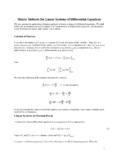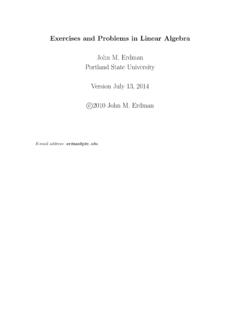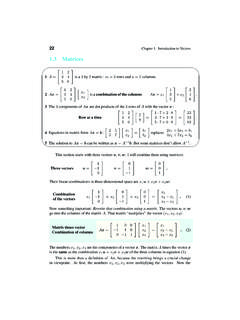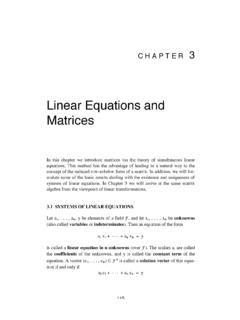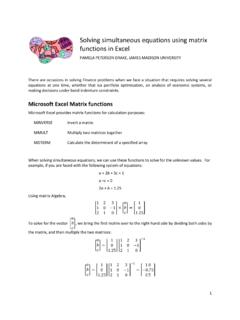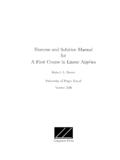Transcription of Elimination with Matrices - MIT OpenCourseWare
1 Elimination with Matrices Method of Elimination Elimination is the technique most commonly used by computer software to solve systems of linear equations . It finds a solution x to Ax = b whenever the matrix A is invertible. In the example used in class, 121 2 A = 381 and b = 12 . 041 2 The number 1 in the upper left corner of A is called the first pivot. We recopy the first row, then multiply the numbers in it by an appropriate value (in this case 3) and subtract those values from the numbers in the second row. The first number in the second row becomes 0. We have thus eliminated the 3 in row 2 column 1.
2 The next step is to perform another Elimination to get a 0 in row 3 column 1; here this is already the case. The second pivot is the value 2 which now appears in row 2 column 2. We find a multiplier (in this case 2) by which we multiply the second row to elimi nate the 4 in row 3 column 2. The third pivot is then the 5 now in row 3 column 3. We started with an invertible matrix A and ended with an upper triangular matrix U; the lower left portion of U is filled with zeros. Pivots 1, 2, 5 are on 2 the diagonal of U. 1 2 1 1 2 1 1 2 1 A = 3 0 8 4 1 0 1 0 2 4 2 U = 0 1 0 2 0 2 5 We repeat the multiplications and subtractions with the vector b = 12.
3 2 For example, we multiply the 2 in the first position by 3 and subtract from 12 to get 6 in the second position. When calculating by hand we can do this efficiently by augmenting the matrix A, appending the vector b as a fourth or final column. The method of Elimination transforms the equation Ax = b into 12 1 a new equation Ux = c. In the example above, U = 02 2 comes from 00 5 2 A and c = 6 comes from b. 10 The equation Ux = c is easy to solve by back substitution; in our example, z = 2, y = 1 and x = 2. This is also a solution to the original system Ax = b. 1 The determinant of U is the product of the pivots.
4 We will see this again. Pivots may not be 0. If there is a zero in the pivot position, we must ex change that row with one below to get a non-zero value in the pivot position. If there is a zero in the pivot position and no non-zero value below it, then the matrix A is not invertible. Elimination can not be used to find a unique solution to the system of equations it doesn t exist. Elimination Matrices The product of a matrix (3x3) and a column vector (3x1) is a column vector (3x1) that is a linear combination of the columns of the matrix. The product of a row (1x3) and a matrix (3x3) is a row (1x3) that is a linear combination of the rows of the matrix.
5 We can subtract 3 times row 1 of matrix A from row 2 of A by calculating the matrix product: 100 121 121 310 381 = 02 2 . 001 041 041 The Elimination matrix used to eliminate the entry in row m column n is denoted Emn. The calculation above took us from A to E21 A. The three Elimination steps leading to U were: E32(E31(E21 A)) = U, where E31 = I. Thus E32(E21 A) = U. Matrix multiplication is associative, so we can also write (E32E21)A = U. The product E32E21 tells us how to get from A to U. The inverse of the matrix E32E21 tells us how to get from U to A. If we solve Ux = E Ax = Eb, then it is also true that Ax = b.
6 This is why the method of Elimination works: all steps can be reversed. A permutation matrix exchanges two rows of a matrix; for example, 010 P = 100 . 001 The first and second rows of the matrix PA are the second and first rows of the matrix A. The matrix P is constructed by exchanging rows of the identity matrix. To exchange the columns of a matrix, multiply on the right (as in AP) by a permutation matrix. Note that matrix multiplication is not commutative: PA = AP. Inverses We have a matrix: 1 0 0 E21 = 3 0 1 0 0 1 2 which subtracts 3 times row 1 from row 2. To undo this operation we must add 3 times row 1 to row 2 using the inverse matrix: 100 E 1 = 310.
7 21 001 In fact, E 1 = E21 3 MIT OpenCourseWare linear Algebra Fall 2011 For information about citing these materials or our Terms of Use, visit.











